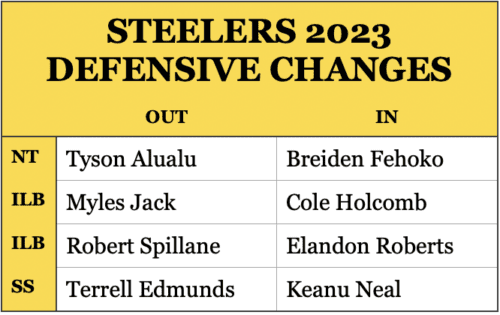Steelers News
How Do Steelers New Defensive Additions Fit Together?

The Pittsburgh Steelers set out to improve their run defense in 2022, and in a season where the NFL as a league ran the ball more than it has in quite some time, the Steelers made huge strides in that area.
But this offseason, most of the team’s run-stopping defensive personnel has changed over, presenting a jigsaw puzzle for defensive coordinator Teryl Austin in terms of how the new pieces will come together to stop the run.
The 2022 season saw NFL teams run the ball an average of 27.2 times per game for 121.6 yards. Those numbers are up from 26.6 and 115.2 in 2021. The last time teams averaged more than 27.2 carries per game was 2011. The last time they gained more than 121.6 yards per game on the ground was 1987. That’s two years before current Steelers elder statesman Cam Heyward was born.
So the league is indeed seeing a historic resurgence of the running game, but it’s a very different-looking running game than the one that was setting Bo Jackson up for Techmo Bowl levels of domination in the late 1980s. (Jackson averaged an absurd 6.8 yards per carry in 1987. The video game wasn’t far off.)
Today, instead of big running backs, fullbacks and tight ends, the league is running more than ever out of what previously were passing formations, and with passers themselves. Quarterback Justin Fields (Chicago, 1,143 yards) with seventh in the league in rushing. Lamar Jackson (Baltimore, 764 yards) was his team’s best rusher despite playing only 12 games. Josh Allen (Buffalo, 762 yards), Jalen Hurts (Philadelphia, 760 yards), Daniel Jones (New York Giants, 708 yards), Taysom Hill (New Orleans, 575 yards) all were among the top 50 runners.
So that means the traditional bulwark against running the football, additional defensive linemen, might not be the most useful to combat this new wave of runners.
In the Pittsburgh Steelers’ base 3-4 defense, they employ a nose tackle and two defensive ends all on the interior of the offensive line, all with two-gap responsibility. That lets the four linebackers flow to the football cleanly.
But the base 3-4 doesn’t handle spread personnel well in pass defense, so the Steelers have shifted to a 4-2 Nickel as their most-common defense, even though they still call the 3-4 their base. The biggest change from the 3-4 to the 4-2, and the biggest change we’ve seen to the Pittsburgh defense over the last 15 years, is the more and more frequent removal of the nose tackle for a slot cornerback.
Last season for the Steelers, run-down slot corner Art Maulet played 481 snaps. Tyson Alualu played 66 snaps of nose tackle and Montravius Adams played 170 for a total of 236. So while running was up, the Steelers were not able to use more defensive linemen to stop it.
So on the surface, it seem that new nose tackle Breiden Fehoko (172 snaps at nose tackle with Los Angeles Chargers 2022) will be limited in his impact to improve the team’s run defense. Head coach Mike Tomlin agreed with that assessment.
“The nose’s participation is not necessarily run or pass-oriented,” Tomlin said. “It’s usually personnel oriented. People have been running out of three-receiver sets for a long time. So, just because there’s an uptick in the run game, doesn’t necessarily mean people will be doing so out of base personnel or a group that produces the opportunity for noses.”
 Instead, it will be the team’s strong safety and off-ball linebackers that will absorb much of the responsibility in most situations, and those groups will be brand-new, as well. Cole Holcomb and Elandon Roberts figure to start at linebacker, with Keanu Neal stepping in for Terrell Edmunds as the primary in-the-box safety.
Instead, it will be the team’s strong safety and off-ball linebackers that will absorb much of the responsibility in most situations, and those groups will be brand-new, as well. Cole Holcomb and Elandon Roberts figure to start at linebacker, with Keanu Neal stepping in for Terrell Edmunds as the primary in-the-box safety.
But not every opponent is the same. Against the likes of a team like the Chicago Bears, with Fields but not a dominating running back, that more spread-out defense makes sense. In the AFC North, however, there are still plenty of teams that like to run heavy personnel.
The Steelers used a nose tackle in just 21 snaps between two games against the Cincinnati Bengals, mostly on the goal line. The Bengals almost always play with a three-receiver formation. In one game alone against the Jackson-less Ravens, the Steelers used a nose tackle on 40 snaps.
With the addition of four very different run-stopping options, the Steelers are trying to give their defense overall ability against the run combined with the ability to succeed in run-heavy situations.
The Steelers were ninth in overall rushing yards allowed last season and tied for sixth in yards per carry against. That’s good. But twice last season, against the New England Patriots and Baltimore Ravens at home, the Steelers needed stops in obvious running situations in order to get their offense the ball back and were unable to.
That’s where a nose tackle like Fehoko, a run-first linebacker like Roberts or an in-the-box safety line Neal will be useful. Other games, they might hardly play, giving way to players like DeMarvin Leal and Damontae Kazee, whose skillsets are more aligned to playing the pass.
The big-picture idea behind all of the Steelers’ offseason defensive moves is that a lot of times, it’s really hard for one player to fill a full-time role given the changing nature of NFL offenses.
It’s easier for the Steelers to find one nose tackle (Fehoko), one three-technique defensive tackle (Ogunjobi) and one five-technique (Leal), one run-first linebacker (Roberts) and a pass-first one (TBA), one pass-coverage safety (Kazee) and one in-the-box guy (Neal), than it is to find do-it-all guys at those positions.
It’s also cheaper. None of the players the Steelers signed on defense this year have broken the bank.
The overall idea behind the Steelers’ offseason defensive plans has been to identify the team’s superstar defenders like Minkah Fitzpatrick, Heyward and T.J. Watt and surround them with pieces that don’t necessarily need to play full-time, but can be exchanged piece for piece in order to best fit the game scenario.














